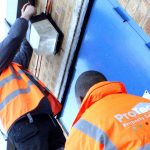Posted on January 31, 2022 in General Info

Prevent Falls
Falls occur when someone is working above ground level and loses their footing, causing them to fall to the ground. This probably makes you think of people working on a ladder or on a roof, but the reality is that many serious or fatal fall injuries are from falls below head height. Sometimes all it takes is hitting your head hard or landing on a limb at a bad angle to incur a serious injury.
Fall hazards need to be taken into serious consideration. Falls are the single biggest cause of workplace fatalities and are one of the main causes of major injuries.
Hazards may be created by:
- Working on a ladder incorrectly or using one that is not stable.
- Working on a mobile elevated work platform (MEWP) that is not safe for use.
- Working close to an opening, hole in the ground, or excavation site.
- Working on scaffolding or the back of a truck unsafely.
- Not using safety gear when working at height, e.g. harnesses.
- Using inappropriate platforms for accessing heights, e.g. chairs and tables.
- Surrounding hazards, e.g. high winds, overhead power lines, and other at-height obstructions that can throw off a person’s balance.
Fall hazards may also be indirect. For example: slip and trip hazards at height puts a person at risk of falling even if they are doing everything else right, as does faulty equipment that could cause an electric shock and make the person suddenly jerk backwards.
Tips for Preventing Fall Hazards:
Safety equipment: use airbags and safety nets below at-height work areas and ensure people are equipped with fall arrest harnesses. Use scaffolding, podium steps, and MEWPs where needed (equipment used for lifting people must adhere to regulations).
Ladder safety: only use ladders and stepladders for up to 30 minutes and always rest them on a firm, level surface. Do not lift more than 10kg up a ladder, do not overreach, and do not use the top 3 rungs and platform. Furthermore, make sure the ladder is leaned against a solid, stable surface and locking devices are fully engaged.
Good work practices: do not use any unsuitable platforms for accessing heights, e.g. a chair. Always use a proper ladder and follow safe procedures.
Instruction and training: follow all instruction and training provided for working at height safely. Use your initiative: discontinue work activities if conditions are evidently unsafe, e.g. high winds or an unstable ladder.
Barriers: when working at height or near excavation sites, barriers must be erected or already in place to prevent people from falling, i.e. guards on scaffolding and MEWPs and fences around holes in the ground.
Space: ensure there is plenty of open space around the area when working at height: each platform requires a minimum amount of space. Having to duck or twist will increase the risk of losing footing and falling.
Equipment maintenance: ensure that equipment used for working at height, e.g. MEWPs and ladders, is installed safely, fully operational, and free of issues. Carry out pre-use checks on equipment before using it.
Prevent other hazards: eliminate slip and trip hazards, as well as risks of electrocution by ensuring that equipment is free of faults.
For information on our commitment to Health & Safety please visit Protech Stay Safe or call 0845 604 1288 and speak with one of our friendly team.
Categories
- Building Maintenance
- Cleaning
- Electrical
- Gardening
- General Info
- Our Service
- Pest
- Security
- Uncategorized
- Waste Solutions
Archive
- July 2024
- June 2024
- May 2024
- April 2024
- March 2024
- February 2024
- January 2024
- December 2023
- November 2023
- August 2023
- April 2023
- February 2023
- January 2023
- December 2022
- November 2022
- October 2022
- September 2022
- August 2022
- July 2022
- June 2022
- May 2022
- April 2022
- March 2022
- February 2022
- January 2022
- December 2021
- October 2021
- September 2021
- August 2021
- July 2021
- June 2021
- May 2021
- April 2021
- March 2021
- February 2021
- January 2021
- December 2020
- November 2020
- October 2020
- September 2020
- August 2020
- July 2020
- June 2020
- May 2020
- April 2020
- March 2020
- February 2020
- January 2020
- December 2019
- November 2019
- October 2019
- September 2019
- August 2019
- July 2019
- June 2019
- May 2019
- April 2019
- March 2019
- February 2019
- January 2019
- December 2018
- November 2018
- October 2018
- September 2018
- August 2018
- July 2018
- June 2018
- May 2018
- April 2018
- March 2018
- February 2018
- January 2018
- December 2017
- November 2017
- October 2017
- September 2017
- August 2017
- July 2017
- June 2017
- May 2017
- April 2017
- March 2017
- February 2017
- January 2017
- December 2016
- November 2016
- October 2016
- September 2016
- August 2016
- July 2016
- June 2016
- May 2016
- April 2016
- March 2016
- February 2016
- January 2016
- December 2015
- November 2015
- October 2015
- September 2015
- August 2015
- July 2015
- June 2015
- May 2015
- April 2015
- March 2015
- February 2015
- January 2015
- October 2014
- May 2013
- April 2013
- November 2011
- September 2011
- June 2011
- January 2011
- December 2010
- November 2010

